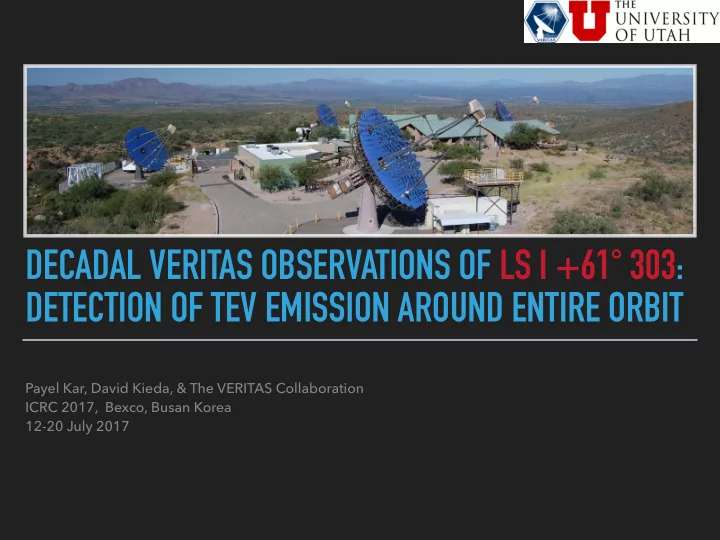

DECADAL VERITAS OBSERVATIONS OF LS I +61° 303: DETECTION OF TEV EMISSION AROUND ENTIRE ORBIT Payel Kar, David Kieda, & The VERITAS Collaboration ICRC 2017, Bexco, Busan Korea 12-20 July 2017
OUTLINE OF THE TALK ▸ An Outline of VERITAS Observatory & TeV Binaries ▸ LS I +61 303 system ▸ Phase based flux analysis and discovery of quiescent emission ▸ Spectral Energy Distribution in different parts of the orbit ▸ Pulsar Flip-Flop Model ▸ Conclusions Payel Kar 2 Decadal VERITAS Observation of LS I +61° 303 | ICRC 2017
VERITAS OBSERVATORY ▸ 4 Imaging Atmospheric Cherenkov Telescopes in AZ, US ▸ Fully Operational since Sep 2017 ▸ Energy Range 85GeV to > 30TeV ▸ Field of View 3.5° ▸ Angular resolution ~0.1° ▸ Sensitivity: 5 σ detection of 1% Crab in <25h ▸ Upgrades: T1 relocation, mirror alignment, trigger, PMTs, etc. Payel Kar 3 Decadal VERITAS Observation of LS I +61° 303 | ICRC 2017
TEV BINARIES: MODELS & MOTIVATIONS Pulsar + Be Star ▸ All gamma ray binaries are not TeV binaries, Only 5 out of >120 HMXB gamma rays >100 GeV ▸ They could be pulsar wind or accretion powered, microquasar gamma-ray emitter yet to be confirmed Microquasar ▸ Varibility patterns generally depends on orbital periods ▸ Other variability patterns also present, micro flares, periodic flares, multi-year cycles etc. Pulsar + Massive Star ▸ Influence of stellar winds on variability patterns (?) ▸ Are there more in our galaxy or nearby ? Mirabel, I.F. Science 312, 1759 (2006) Payel Kar 4 Decadal VERITAS Observation of LS I +61° 303 | ICRC 2017
LS I +61° 303 : ORBITAL PARAMETERS Relative Orbit of Compact Object Disc of Be Star Apastron (when farthest away) Center of Mass Periastron (closest approach) Sierpowska-Bartosik et al. 2009 ApJ 693.1462S Payel Kar 5 Decadal VERITAS Observation of LS I +61° 303 | ICRC 2017
LS I +61° 303 : PREVIOUSLY BY VERITAS ‣ 2009-2010 no TeV detection near apastron 2010 TeV detection in singe orbit near periastron passage Flaring activity in 2011 (15% of Crab), in 2014 (30% of Crab) Payel Kar 6 Decadal VERITAS Observation of LS I +61° 303 | ICRC 2017
LS I +61° 303 : VERITAS OBSERVATION SET 21.4 σ 1746 m 6.2 σ 16.0 σ 1518 m 14.0 σ 12.4 σ 6.5 σ 1137 m 1551 m 490 m 703 m 4.6 σ 5.6 σ 3.8 σ 0.7 σ 522 m 933 m 2305 m 1207 m Payel Kar 7 Decadal VERITAS Observation of LS I +61° 303 | ICRC 2017
LS I +61° 303 : PHASE BINED ANALYSIS ▸ Φ 0 = MJD 43366.275 Overlaid on J. Casares,et al., MNRAS, 360 (2005), pp. 1105–1109 ▸ 10 phase bins ▸ Bin width ΔΦ =0.1 ▸ >5 σ in 9 of 10 bins 4% 8% 7% 5% 10% 14% 10% 23% 13% 4% DATA IN EACH BIN Payel Kar 8 Decadal VERITAS Observation of LS I +61° 303 | ICRC 2017
LS I +61° 303 : PHASE BINED FLUX ▸ ~3% Crab quiescent emission ▸ TeV outburst near apastron passage ▸ Limited exposure UL in 1 phase ▸ Highly variable VHE emission 4% 8% 7% 5% 10% 14% 10% 23% 13% 4% DATA IN EACH BIN Payel Kar 9 Decadal VERITAS Observation of LS I +61° 303 | ICRC 2017
LS I +61° 303 : SPECTRAL ENERGY DISTRIBUTIONS Payel Kar 10 Decadal VERITAS Observation of LS I +61° 303 | ICRC 2017
LS I +61° 303 : SPECTRAL ENERGY DISTRIBUTIONS LS 5039 H.E.S.S. COLLABORATION ICRC 2015 HESS J0632+057 G. MAIER, VERITAS COLLABORATION ICRC 2017 Payel Kar 11 Decadal VERITAS Observation of LS I +61° 303 | ICRC 2017
LS I +61° 303 : A NEUTRON STAR MODEL R. Zamanov, et al. 2 nd National Conference on Astrophysics of Compact Objects, Sept. 2001, p. 50 ‣ Ejector Phase: EM pressure expelled relativistic particles is high, sweep away the surrounding matter beyond capture radius ‣ Propeller Phase: Outward EM pressure is balanced with the inward pressure from the surrounding medium. No Accretion but matter gathers around the magnetosphere ‣ LS I +61 303 flip-flop along the orbit between E-P ‣ Ejector during TeV outburst near apastron ‣ Rest Propeller ‣ Microquasar & Colliding Wind pulsar models could explain with modifications. Payel Kar 12 Decadal VERITAS Observation of LS I +61° 303 | ICRC 2017
LS I +61° 303 : SUMMARY ‣ 10y of observations, 240h of data ‣ LS I +61 303 flip-flop along the orbit, Ejector during TeV outburst near apastron, Propeller for rest of the orbit ‣ Quiescent TeV emission at for Propeller ‣ TeV outbursts for Ejector ‣ Spectral studies along the orbit ‣ Microquasar & Colliding Wind pulsar models could explain with modifications. Payel Kar 13 Decadal VERITAS Observation of LS I +61° 303 | ICRC 2017
Recommend
More recommend